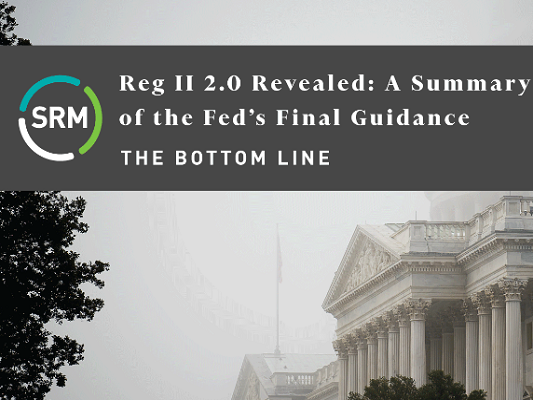|
by Myron Schwarcz, Chief Product Officer, and Keith Ash, Senior Vice President, SRM
It has been almost a year and a half since the Fed had requested public comment on a “non-substantive” proposed amendment to Regulation II that would 1.) specify that the prohibition on network exclusivity applies to card-not-present debit card transactions, 2.) clarify the responsibility of the issuer to enable at least two unaffiliated networks to comply with the prohibition on network exclusivity, and 3.) standardize and explain the use of certain terminology. The proposal was anything but non-substantive and would have fundamentally altered issuers’ compliance obligations under Durbin. The Fed received more than 2,750 comments, and it has taken nearly a year since the comment period was completed to receive a final ruling. The ruling has finally arrived. So, what is in the final rule? The final rule is similar to what many have expected. It requires debit card issuers to enable two unaffiliated networks across all geographies, merchants, and particular transaction types (specifying that card-not-present is a particular type of transaction). However, the Fed clarifies that the issuer’s obligation does not mean it has to ensure that each merchant accepts the networks in which an issuer participates. The final rule also includes specific changes that make it easier for issuers to determine whether they already comply with the prohibition on network exclusivity. The Fed retained the approach that allows issuers to rely on network rules or policies in determining whether the networks enabled by an issuer may be used to satisfy the prohibition on network exclusivity. Most, but not all, of the proposed revisions to the commentary standardizing and clarifying the use of certain terminology was adopted. The rule goes into effect on July 1, 2023. What did the final rule not include? The final rule does not directly address interchange for debit card transactions. The change was limited in scope; however, it is explicitly noted that the Board will continue to review the regulation in light of the most recent data collected by the Board and may propose additional revisions in the future. The limited data collected by the Board showed a decrease of over 50% in processing fees from the implementation of Reg II; however, interchange has not been adjusted since the regulation went into effect. We would not be surprised if the Fed took a hard look at regulated interchange in 2023. Our Perspective It is concerning but not surprising the Fed has taken a narrow view on the many topics addressed in the public comments. Many issuers and related trade associations expressed great concern about the economic damage this amendment will cause, including higher costs, reduced interchange revenue, increased fraud, and the associated impact it will have on consumers. While the Fed acknowledged potential impacts, it was mostly unsympathetic, stating that the only issuers who will be impacted are those who have not already made the change. This was shocking given the relative prevalence of card-not-present fraud, and that fraud solutions for single-message transactions in an e-commerce environment are not as robust as their dual-message counterparts. The Fed made it clear that it believes increased competition would benefit merchants by encouraging networks to develop innovative solutions to address these fraud concerns. Another example of the Fed’s focus on merchants over consumer impact was its acknowledgment that issuers may pass on the increased costs to consumers (precisely what happened in the original legislation.) The Fed’s study revealed that it occurred with the original piece of legislation. Additionally, a Boston University Law review study revealed that more than one million consumers lost access to the banking system due to Reg II. All the while, the Fed has stated there is no evidence that the merchants who received billions in what was a government allocation of revenue have passed on any of the savings to consumers. What is most concerning is the timing of the change. Many issuers have already established budgets for 2023 and publishing a rule in Q4 that has a financial impact in the following year could again trigger negative consequences for consumers as issuers plan to negate the revenue impact this legislation will cause. The Fed is correct in its commentary that when Reg II was finalized, it allowed issuers about nine months to comply. However, the rule was published in July 2011, well before most issuers completed their budgets. In an unsurprising development, the Fed noted that single-message networks (among other parties) uniformly supported the proposal. While their focus is certainly to grow network volume, the issuers who participate in such networks may want to contemplate how they partner with networks whose interests may conflict with their own. It is difficult to understand why the Fed would take such an action that could be so damaging for community banking institutions. Unlike large issuers who are already subject to interchange restrictions, smaller institutions are going to bear the direct brunt of this regulation. Any material degradation in non-interest income or increase in fraud expense may accelerate the already rapid consolidation in the community banking segment further eroding consumer choice for banking providers. Impacted issuers should pay close attention to potential financial (2023 budget), contractual, operational, and technology implications of this new rule. In addition, all issuers should be prepared that this is just the beginning. The next two items on the battlefield are 1.) regulated debit interchange levels and 2.) a similar dual network requirement for credit issuers. Senator Durbin has made it clear that this is his priority and is making aggressive moves to address both. For example, Senator Durbin’s latest action is to attach his Credit Card Competition Act to the Armed Forces Bill. Issuers need to pay attention to this more than ever and should actively engage their government relations areas and prioritize this issue at the local and national levels. The time is now…before it is too late. SRM is a DakCU Senior CAP Partner that has been helping a number of Dakota credit unions with card portfolio savings. They have been selected by more than 700 financial institutions to advise in areas such as payments, digital banking, core processing, and operational efficiencies, unlocking billions of dollars in value and improved the competitive advantage of its clients with a reputation for industry-leading subject matter expertise, a proprietary benchmark database, and proven negotiating skills. Visit srmcorp.com for more information or contact Blaine Petersen, Senior Vice President or George McDonald, DakCU’s Chief Officer of Strategic Services. Comments are closed.
|
The MemoThe Memo is DakCU's newsletter that keeps Want the Memo delivered straight to your inbox?
Archives
July 2024
Categories
All
|
|
Copyright Dakota Credit Union Association. All Rights Reserved.
2005 N Kavaney Dr - Suite 201 | Bismarck, North Dakota 58501 Phone: 800-279-6328 | [email protected] | sitemap | privacy policy |






